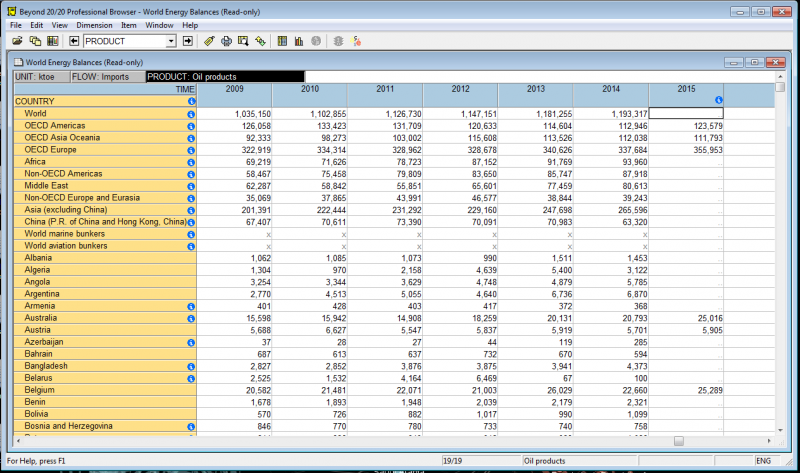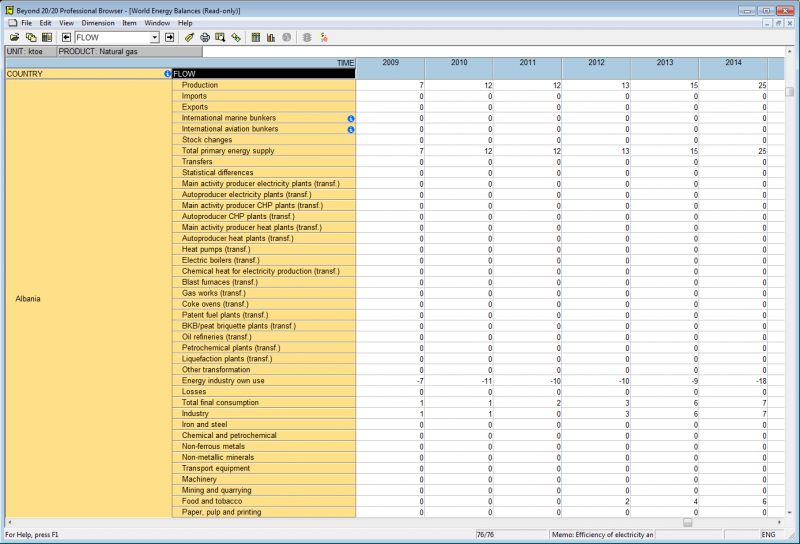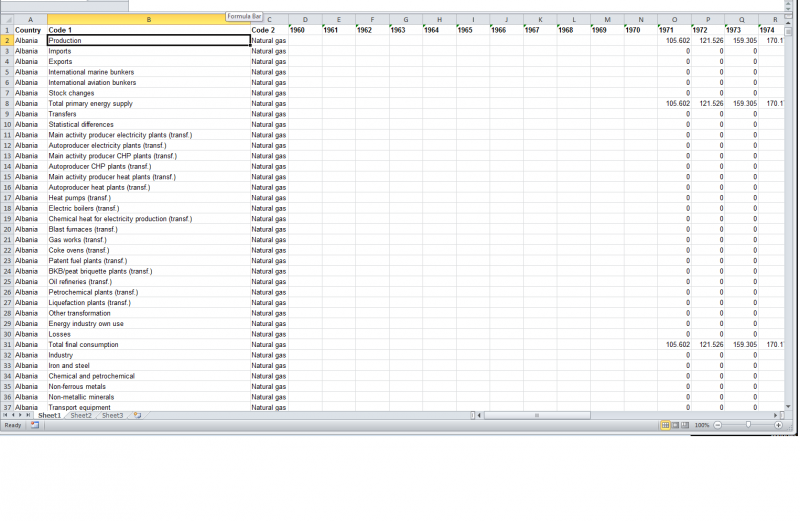International Energy Agency (IEA)
About
The International Energy Agency commenced its operation in 1974 under the auspices of the Organization for Economic Co-operation and Development (OECD). The IEA is the energy forum for 26 Member countries, all from the OECD, to improve the world’s energy supply and to promote reliable databases for energy-related information. IEA member governments are committed to sharing energy information, to co-ordinating their energy policies and to co-operating in the development of rational energy programs. IEA publishes monthly reports on electricity, natural gas, prices, and the oil market. The World Energy Outlook is the IEA's most comprehensive publication, and is considerd " the world’s most authoritative source of energy market analysis and projections."
The main IEA sources used by IFs are the World Energy Balances (WEB) and World Energy Statistics (WES), databases assocated with the World Energy Outlook. They contain variables such as the production, trade, and consumption of coal, oil, gas, electricity, heat, renewables, and waste for OECD countries and over 100 non-OECD countries.
Metadata
Data Acquisition
Unlike most data used in IFs, IEA data from the WEB and WES are not open source. The data must be purchased from the IEA and is delivered on two CD-ROMs.[1] Each disc runs on a database management software program called Beyond 20/20 that comes loaded on the discs, along with the data. Financial support for the purchase of the IEA data is available from a University Library Association grant. Pardee successfully applied for grant funding through this program for the 2017 update with the help of staff at the Anderson Academic Commons at the University of Denver.
Documentation
Full documentation is available for each dataset detailing its contents, structure, definitions, geographical coverage, etc.
World Energy Balances 2016 Database Documentation
World Energy Statistics 2016 Database Documentation
Batch Pull
The IEA update is performed as a Batch Pull that includes 138 series using the Batch Data Update feature in IFs. In the display, "IEA" is the Source, "IEA Countries" are used for country concordance. For the Code Location in Source Data portion of the update form, the source Excel must be formatted so that each Code in Source term is in a different column. For example, SeriesEnImportsOilProductsIEA's Code in Sourse is "Imports.Oil products," so there should be two columns with "Imports" in one and "Oil products" in the next.
Series Codes
Because this is a batch pull, each series needs a Code in addition to a variable name to be imported. The codes are listed in the DataDict, and should match (or be extremely close to) the series name in the IEA source database. For the 2017 update, series on the WEB and WES discs were organized by two parameters, FLOW and PRODUCT, where FLOW is the first term of the Code and PRODUCT is the second term of the Code. Drag and drop FLOW, PRODUCT, UNIT, and COUNTRY to column and row headers to reconfigure the display in Beyond 20/20.
Example
Variable: EnImportsOilProductsIEA
Code: Imports.Oil products
FLOW: Imports
PRODUCT: Oil products
Pulling and Formatting the Data
Pulling
Ideally, the IEA series are pulled from the discs in bulk. As of the 2017 update, Beyond 20/20 limits the number of records that can be exported at one time, preventing all the data from being exported at once; however, it is possible to pull all records by PRODUCT or FLOW. For example, it is possible to pull all natural gas or oil products series at once from the WEB disc. Pull the data by assembling the correct configuration in Beyond 20/20, then going to File>Save As and saving it as a .xls file. It is also possible to copy and past individual (or a few) series into an Excel by highlighting them, but not a large number of series at once. [NOTE: The directly exported Excel file did not work on Pardee computers due to a policy setting issue, so the data had to be copied and pasted into a new sheet to be manipulated]
Formatting
Once the series have been pulled by PRODUCT or FLOW, they need to be cleaned. Missing data are marked with a "..", "x", or "n," so remove these with a Find+Replace. The data can then be imported with the Batch Import tool using the codes assocated with the FLOW and PRODUCT, along with the country name. It may be necessary to also clean the codes, for example if there is a unit listed parenthetically after the name of the product (i.e. "Solar thermal (TJ-net)").
DataDict
Variable: Variable names were not changed from previous years this data was pulled, and no additional variables were added for the 2017 pull.
Table: These were not changed from previous years this data was pulled.
Code in Source: Identifies the series for batch import; were not changed from previous years this data was pulled.
Groups: These were not changed from previous years this data was pulled.
Subgroups: These were not changed form previoys years this data was pulled.
Definitions and Units: These were not changed from previous years this data was pulled.
Extended Source Defn: All were marked as "No Extended Source" for 2017 pull. Units used in this dataset include BBOE and GwHr.
Years: Years for every series were changed to available data provided through the database. Most series begin in 1960 with the exception of EnExportsOilIEA, EnImportsOiliIEA, and EnProdOilIEA, which begin in 1971. All extend through either 2014 or 2015 as of the 2017 update.
Source: The source used in the 2017 update for all batch pull IEA series is "IEA (International Energy Agency) Batch Pull."
Original Source: The original source used in the 2017 update for all series is the "World Energy Outlook."
Notes: Notes were updated to reflect the source disc for the series (WEB or WES), any conversion factors used, and the appropriate initials.
Aggregation: Aggregations were not changed from pervious updates.
Disaggregation: Disaggregations were not changed from previous updates.
Name in source: Was updated based on the name of each variable as it is displayed in the Beyond 20/20 database format; generally matches the Code in Source.
Decimal places: These were not changed from previous years this data was pulled.
Country Concordance: FAO Countries were used.
Formula: These were not changed from previous years this data was pulled, and are either blank or convert data from ktoe to BBOE or GwH
Preprocessor Series
Of the 138 IEA Batch Pull series, 24 are preprocessor. These series should be updated first in any IEA batch update. They include:
| EnExportsCoalIEA |
| EnExportsNatGasIEA |
| EnExportsOilIEA |
| EnExportsOilProductsIEA |
| EnExportsPeatIEA |
| EnExportsTotalIEA |
| EnImportsCoalIEA |
| EnImportsNatGasIEA |
| EnImportsOilIEA |
| EnImportsOilProductsIEA |
| EnImportsPeatIEA |
| EnImportsTotalIEA |
| EnProdBiodieselIEA |
| EnProdBiogasIEA |
| EnProdCoalIEA |
| EnProdGeothermIEA |
| EnProdHydroIEA |
| EnProdNatGasIEA |
| EnProdNuclearIEA |
| EnProdOilIEA |
| EnProdSolarPhotoIEA |
| EnProdSolarThermIEA |
| EnProdTideWaveOceanIEA |
| EnProdWindIEA |
Country Concordance
There is a unique country concordance table for IEA series called "IEA Countries." This table should be checked for accuracy at the time of each update. For the 2017 update, the following countries had to be updated (to the form listed):
| Bosnia and Herzegovina |
| Democratic Republic of the Congo |
| Hong Kong (China) |
| Democratic People's Republic of Korea |
| Libya |
| Moldova |
| Mauritius |
| Niger |
| Suriname |
| South Sudan |
| Tanzania |
| Viet Nam |


